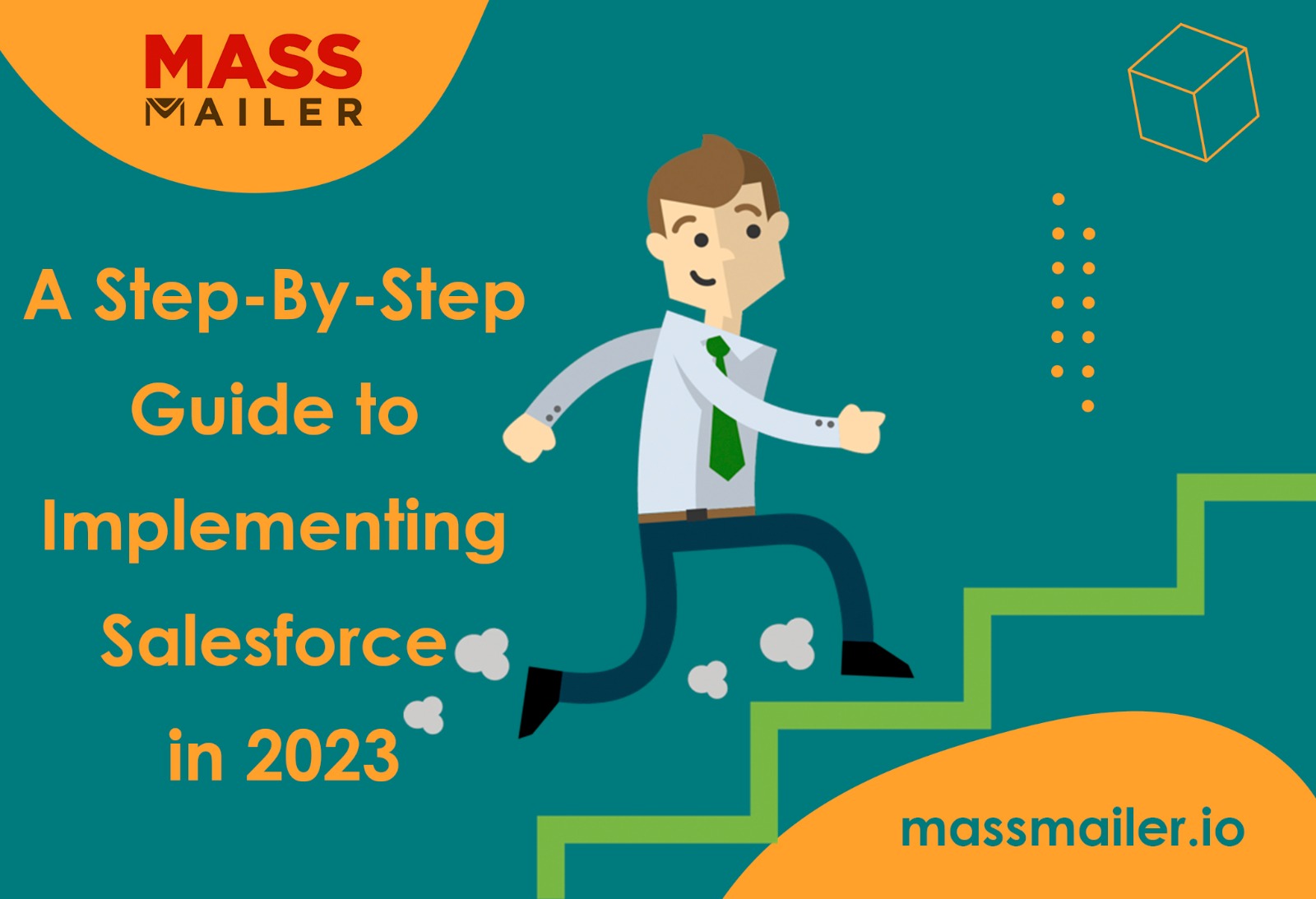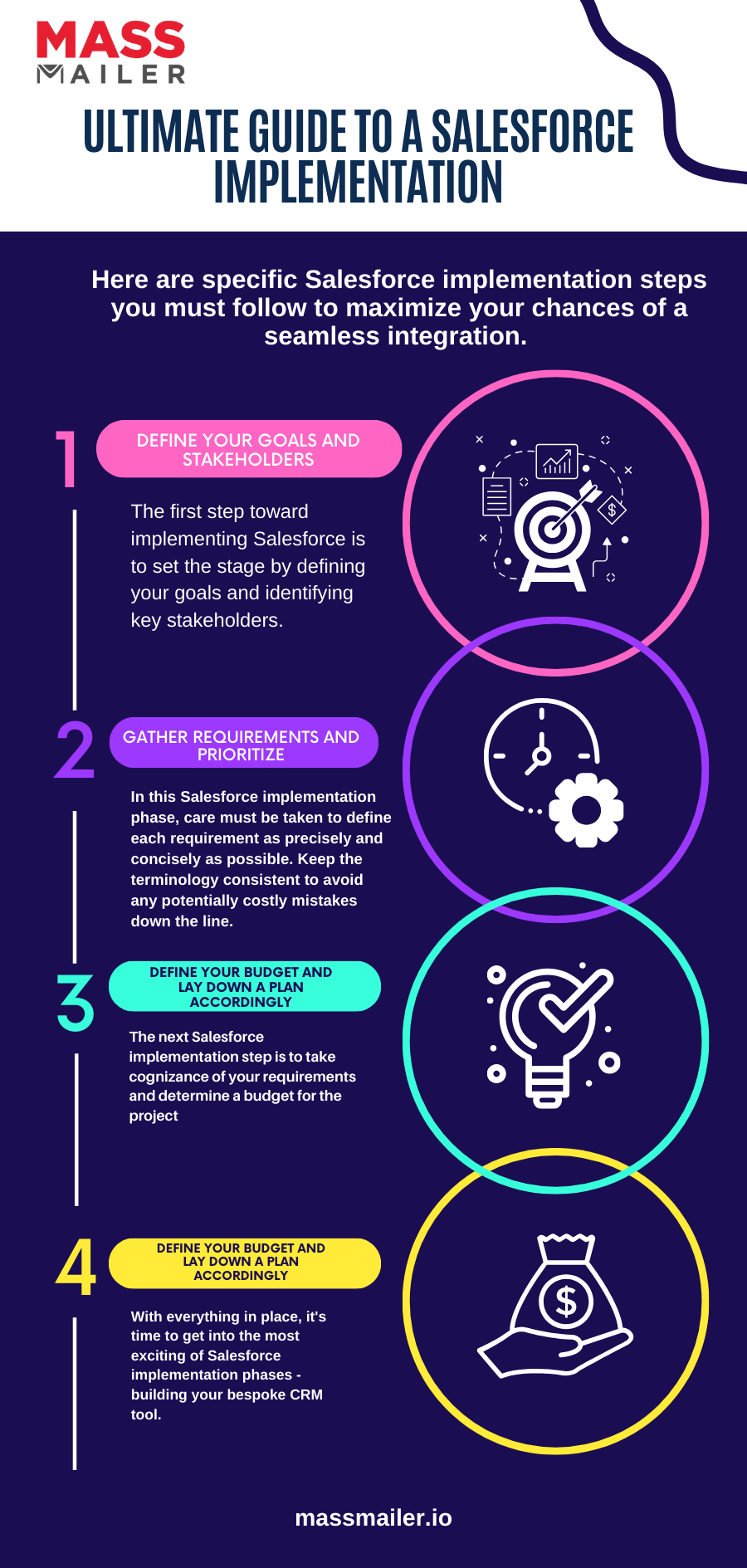A Step-By-Step Guide to Implementing Salesforce in 2023
Salesforce is by far the most popular CRM tool today. According to IDC’s 2023 Worldwide Semiannual Software Tracker, it has been so for ten straight years. While there is no question about the benefits these solutions bring to enterprises, a shocking statistic is that about 1/3 of all Salesforce projects fail.

The problem stems from many factors, ranging from a poorly defined CRM strategy to a lack of sufficient commitment from higher-ups. That said, most of the above pitfalls are avoidable, and if a successful CRM implementation is what you are after, you are in the right place.
This blog will walk you through everything you need to know when implementing Salesforce, along with an implementation checklist so that you don’t have to stare down the barrel of technical debt.
The Different Approaches to Implementing Salesforce
You can take three possible routes to implement Salesforce in your organization.
The DIY Route (In-House Implementation)
As far as implementation goes, this option is the road less traveled. While on the bright side, you can get away with low upfront costs, there is a higher risk of technical debt.
Succinctly put, technical debt is the additional time and cost required to fix or improve a software system that was either implemented poorly or without considering the design’s long-term implications.
Lack of or limited expertise, budget constraints, and tight deadlines are the usual suspects that land you in technical debt. This option is not recommended.
Employing the Services of a Salesforce Implementation Partner
The second and, by far, the best option for implementing Salesforce is to hire a professional Salesforce implementation partner who can help you with the entire process. Over 70% of all Salesforce implementations opt for this route, and here is why:
- They are experts at assessing your business needs and designing a bespoke CRM strategy.
- They can configure and customize Salesforce to fit your specific business requirements.
- They can seamlessly migrate your data from your old CRM tools or other sources to Salesforce.
- They can train your workforce on how to use Salesforce effectively.
- They can provide ongoing maintenance, updates, and troubleshooting.
While this option comes with higher upfront costs, it more than makes up for it with higher revenues in the long run.
A Hybrid Approach
A third possible option is to consider a hybrid approach to implementing Salesforce. If you have a team with solid salesforce expertise that is only lacking in specific areas, you can bring in implementation support for those particular instances.
Now that you have a reasonably good idea of the options available to you let’s get into the intricacies of implementing Salesforce successfully.
 `
`
Salesforce Implementation Steps: A Step-By-Step Guide
No matter which of the three approaches you choose, there are specific Salesforce implementation steps you must follow to maximize your chances of a seamless integration. They are as follows:
1. Define Your Goals and Stakeholders
The first step toward implementing Salesforce is to set the stage by defining your goals and identifying key stakeholders.
This begins with a simple question – What do you hope to achieve with Salesforce? Engage with the key personnel to understand the pain points and use that information to narrow down the scope of the project.
This process goes hand in hand with identifying your internal and external stakeholders, such as business/end users, super users, project managers, and decision-makers, each with distinct roles and responsibilities.
It is also crucial to involve everyone in the planning phase to ensure that everyone is on the same page and that any and all concerns or suggestions are addressed or considered.
Gather Requirements and Prioritize
Now that you have laid down the foundation of your end goals and identified the key stakeholders, the next step in the implementation checklist is to get into the nitty-gritty of what you need and want from the system. This phase is all about gathering your requirements and prioritizing them.
This focus should be on the following parameters:
- The Business impact: How essential is the requirement and the effect it will have?
- Urgency: Does the requirement in question need to be implemented immediately, or can it wait?
- Feasibility: How feasible is the requirement to implement? Do you have the resources and expertise to implement it?
In this Salesforce implementation phase, care must be taken to define each requirement as precisely and concisely as possible. Keep the terminology consistent to avoid any potentially costly mistakes down the line.
Define Your Budget and Lay Down a Plan Accordingly
The next Salesforce implementation step is to take cognizance of your requirements and determine a budget for the project. The cost of implementing Salesforce can vary based on your chosen approach and the complexity of the task at hand.
Once you have crunched the numbers, the next step is to establish a well-defined implementation timeline. If you need help with how to go about this, avail the services of a Salesforce consulting firm. Be realistic with timelines and also account for unexpected delays or cost overruns.
One key aspect of this phase is to account for the maintenance and migration of data. Set aside a budget and come up with a foolproof data migration strategy. It goes without saying that your CRM efforts are directly linked to the quality of your data.
Build, Test, and Work Toward a Phased Launch
With everything in place, it’s time to get into the most exciting of Salesforce implementation phases – building your bespoke CRM tool.
Once you have the first build, thoroughly testing the system in a sandbox environment is vital. If you are working with a salesforce partner, request a demo and go through the implementation checklist to ensure everything in the scope of this phase has been implemented as per requirements.
Once satisfied, roll out your CRM tool in a phased manner. It avoids overwhelming your team with a sudden transition and, at the same time, gives you the leeway to gather feedback and make any changes or improvements as needed.
Summing It Up
Implementing Salesforce requires a fair bit of planning and a lot of expertise. Unless you are confident about your in-house team’s expertise and capability, it’s best to rope in Salesforce consultants to develop the bespoke CRM tool. You can also explore Salesforce App Exchange to add functionality without developing custom code. That said, the steps outlined in this blog will maximize your chances of a successful implementation.
Now that you know how to implement Salesforce successfully, your next step should be to leverage your new CRM tool to take your CRM game up a few notches.
One of the most effective ways to do so is to automate your email marketing campaigns. MassMailer lets you easily create and send targeted email campaigns to your customers and leads right from within Salesforce. Sign up for a free 15-day trial to know how.
